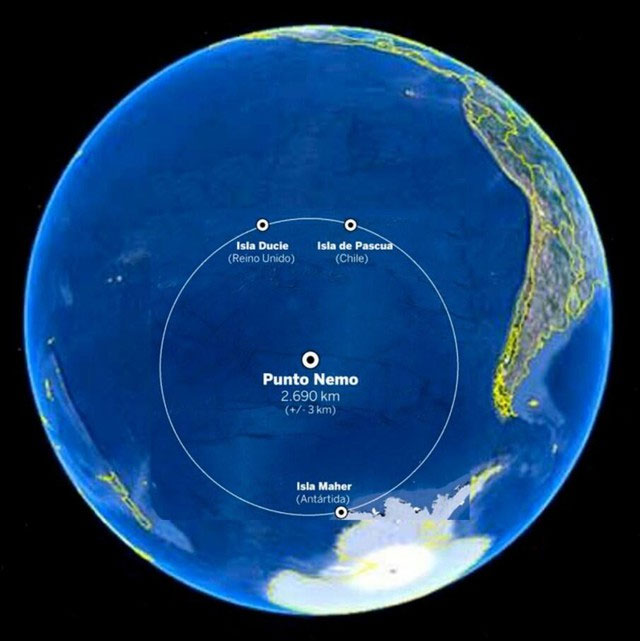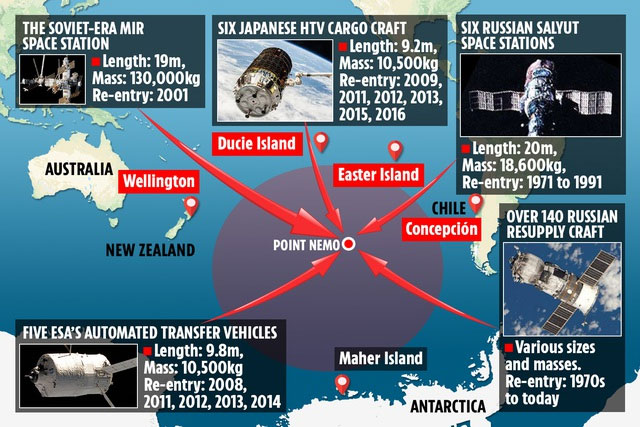At the most remote point on Earth, scientists heard a strange sound with an extremely low frequency
This is one of the loudest underwater sounds ever recorded.
Point Nemo in the South Pacific Ocean is said to be the most remote location on the planet . When ships pass through it, they will be 2,689km from the nearest land. While the International Space Station passes overhead, the distance between the sailors and astronauts on the substation is closer than the distance between the sailors and the mainland, as they are only 400km above their heads.
Because of its isolation and ocean currents with few fish and fishermen, the area has become a graveyard for old spacecraft. Just as old satellites returned to Earth orbit and entered the region, the Soviet/Russian space station Mir ended its "life" at the bottom of the ocean.

Deep in the South Pacific lies a point on Earth's surface that is farther from land than any other location. Called Point Nemo , the point is located about 2,689km (1,450 nautical miles) from the nearest land, making it the most remote and isolated place on the planet. If you've ever used the phrase "mid-ocean," this is also the most accurate phrase to describe Point Nemo.
It was here, in 1997, that the US National Oceanic and Atmospheric Administration (NOAA) detected a strange extremely low-frequency sound . The sounds, detected by hydrophones placed over the Pacific Ocean , were powerful and extremely loud, among the loudest ever recorded underwater.
The noise is a mystery , so loud that it was picked up by hydrophones 4,800km apart. Some people, including NOAA oceanographer Chris Fox, have speculated that the sounds may have been caused by a marine animal.
"There are a lot of noisy things down there. Whales, dolphins or some other fish could be the source of these noises," Fox told CNN .

Point Nemo's remote location makes it an ideal location for space debris to land safely. In fact, the site is so remote that it has been designated a "spaceship graveyard" by the international space community . Satellites and other space debris falling out of orbit often point toward Point Nemo so they can crash safely into the ocean without harming any populated areas. This is quite useful because spacecraft about to crash never land at a specific point but break into thousands of pieces as they enter the atmosphere, the debris fall zone can be tens of miles wide and thousands of miles long.
In fact, there is no known animal capable of making such a sound , leading to some speculation that it may be a giant squid or another unknown sea monster. . However, at the time Fox also offered another explanation that seemed more reasonable.
"I think it might have something to do with the ice cracking into big icebergs, or big icebergs scraping the ocean floor ," Fox added. "It always comes from the south. We suspect that it is ice off the coast of Antarctica ."

Despite being considered the most isolated place on Earth, Point Nemo still attracts a number of intrepid travelers willing to make the journey to this remote location. It should be noted that visiting Point Nemo is no easy feat, as it requires a long and expensive voyage through some of the roughest seas on Earth. The journey is often undertaken by scientific expeditions who are interested in studying the region's unique ocean currents and dynamics.
NOAA has also detected sounds similar to bloops before and even used them to track iceberg A53a as it disintegrated.
"Broad-spectrum sounds recorded in the summer of 1997 are consistent with earthquakes produced by icebergs as they crack and break," the Pacific Marine Environmental Laboratory explains .
"The earthquakes were of sufficient amplitude to be detected on multiple sensors at a range of over 5,000km. Based on the azimuth of arrival, the icebergs that produced the bloop were most likely located between Bransfield Strait and the Ross Sea , or possibly at Cape Adare".

Point Nemo is located right in the middle of the South Pacific Gyre, a large system of ocean currents circulating in the South Pacific that rotate clockwise around a central point in the ocean. Because it is so far from land, there are virtually no dust particles or runoff from the land, so the water has extremely low concentrations of nutrients. This makes the vast area around Point Nemo a giant ocean desert. There are no sharks or big fish. Phytoplankton, tiny algae that form the bottom of the marine food chain, are only found at depths of more than one hundred meters. But despite its remoteness and lack of large marine life, the South Pacific gyre is rich in bacteria and other microorganisms, contributing significantly to global biogeochemical cycles. Small crabs have also been found near an undersea volcano near Point Nemo.
- The Hum - The mysterious sound challenges the scientific world
- The scaryness of sound: saving people and destroying each other in a narrow way!
- Listen to the mysterious sound obtained from the deepest
- Can shoot down unmanned aircraft with sound
- The globe is near the sun most of the year
- Why can sound break glass?
- For the first time the light is stored as a sound wave
- Revealing information about the phenomenon of the
- The story now knows about the sound that everyone should hear
- Places of evil appear in Hong Kong
- Decipher the mystery of the scary sound coming from the Golden Gate Bridge in the US
- Mysterious sounds like the sound of
 'Fine laughs' - Scary and painful torture in ancient times
'Fine laughs' - Scary and painful torture in ancient times The sequence of numbers 142857 of the Egyptian pyramids is known as the strangest number in the world - Why?
The sequence of numbers 142857 of the Egyptian pyramids is known as the strangest number in the world - Why? History of the iron
History of the iron What is alum?
What is alum? The largest crane in the world, capable of lifting 5,000 tons of cargo at a time
The largest crane in the world, capable of lifting 5,000 tons of cargo at a time  If you want to stay away from humans, this is where you need to be
If you want to stay away from humans, this is where you need to be  Do you know where to be lonely and away from the most people on Earth?
Do you know where to be lonely and away from the most people on Earth?  Which mountain is the highest from the center of the earth?
Which mountain is the highest from the center of the earth?  The list of 5 points can be answered on comets
The list of 5 points can be answered on comets  The globe is near the sun most of the year
The globe is near the sun most of the year 